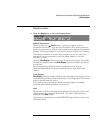
4-29
MegaZoom Concepts and Oscilloscope Operation
To capture a single event
To capture a single event
To capture a single event, you need some previous knowledge of the signal to
set up the trigger level and slope. For example, if the event is derived from TTL
logic, a trigger level of 2 volts should work on a rising edge. These steps show
you how to use the oscilloscope to capture a single event.
1 Connect a signal to the oscilloscope.
2 Set up the trigger.
a Define an edge, pulse width, pattern, or other advanced trigger type.
b Press the Mode/Coupling key and set trigger Mode to Normal.
c If you are using the analog channels to capture the event, turn the trigger
Trigger Level knob to the trigger threshold where you think the trigger
should work.
3Press the Single key.
Pressing the Single key arms the trigger circuit and the Single key will be
illuminated. When the trigger conditions are met, data appears on the display,
representing the data points that the oscilloscope obtained with one acquisition
and the Run/Stop key will be illuminated red. Pressing the Single key again
re-arms the trigger circuit and erases the display.
Operating Hints
When Trigger Mode is set to Auto or AutoLvl (auto-single mode), each time Single
is pressed the oscilloscope will wait for a valid trigger. If no trigger is found after
about 40 ms, the oscilloscope will force a trigger, acquiring whatever signal is
present. This is a handy mode to look for totally unknown situations.
When Trigger mode set to Normal, pressing Single will arm the trigger circuit and
do a single acquisition when a valid trigger is seen.
You can use recalled traces to compare several single-shot events. See the "Saving
and Recalling Traces and Setups" section later in this chapter.


















